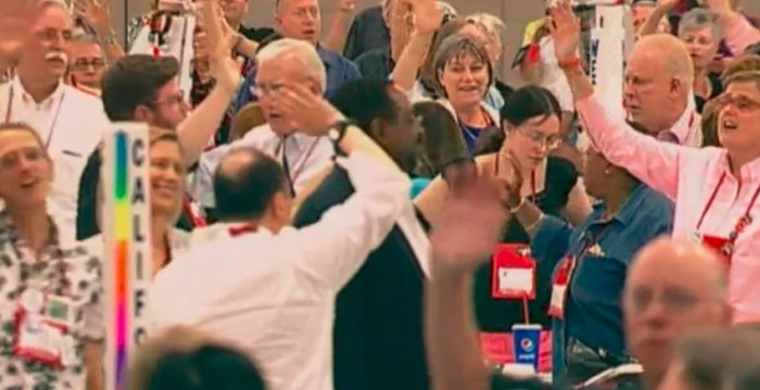New Numbers Detail Uneven Episcopal Decline
By Jeff Walton
https://juicyecumenism.com/2015/12/04/new-numbers-detail-uneven-decline-across-episcopal-church/
December 4, 2015
The Episcopal Church continued its membership and attendance decline in 2014, but dioceses and provinces (regions) of the U.S.-based church varied widely in their rate of decline, with some treading water while others posted sharp declines.
New statistical summaries and trend reports released today by the denomination's Office for Research supplement raw statistics released back in early October, which can be viewed here. http://tinyurl.com/puu836v More than two months following the release of updated statistics, the Episcopal News Service still has not provided coverage of the denomination's changes in the most recent reporting year.
As IRD reported in October, the church's domestic U.S. membership dropped -2.7 percent from a reported 1,866,758 members in 2013 to 1,817,004 in 2014, a loss of 49,794 persons. Attendance took an even steeper hit, with the average number of Sunday worshipers dropping from 623,691 in 2013 to 600,411 in 2014, a decline of 23,280 persons in the pews, down -3.7 percent.
The new trend summaries reveal that 53 percent of Episcopal congregations report a 10 percent or greater decline in attendance over the past five years, while only 18 percent show 10 percent or greater attendance growth during the same time period. Seventy percent of Episcopal congregations have fewer than 100 attendees, with the denominational median congregation down to 60 attendees. The denomination reports a 25 percent decline in attendees and a 19 percent decline in membership during the past 10 years. Only 4 percent of Episcopal congregations report an average attendance of greater than 300 persons.
The decreasing numbers have had an effect upon the ability of smaller congregations to employ full-time clergy. In a first, a plurality of Episcopal congregations in 2014 (34.5%) have only a part-time or unpaid priest, outnumbering those with a lone full-time priest.
Among the church's regions, Province IV (Southeast, membership -5%, attendance -7.1%) and Province IX (Caribbean/Central America, membership -9%, attendance -5.7%) took the steepest hits, while Province VII (South Central) reported modest membership and attendance losses below 1%. Collectively, non-domestic dioceses posted a modest attendance growth (uniquely in the entire Episcopal Church) although their membership numbers were weighed down by the Diocese of Honduras dropping -19.2%, the second year in a row that the Latin American diocese has dramatically revised its numbers.
Specific dioceses posting sharp losses are concentrated primarily in the Northeast, Rustbelt and rural areas including Connecticut (membership -3.6%, attendance -5%), Massachusetts (membership -4%, attendance -3.7%), Central New York (membership -3.6%, attendance -5.2%), Long Island (membership -5.1%, attendance -3.3%), Western New York (membership -6.6%, attendance -4.5%), Northwest Pennsylvania (membership -4%, attendance -7.2%), Kentucky (membership -5.6%, attendance -5%), Chicago (membership -3.7%, attendance -6.8%), Eastern Michigan (membership -4.6%, attendance -6.4%), Milwaukee (membership -4.8%, attendance -3.5%) and Northern Indiana (membership -5.6%, attendance -4.9%).
Rural dioceses have dwindled to the point where their long-term viability is in question. The tiny Diocese of Northern Michigan (membership -7.4%, attendance -3.2%), Western Kansas (membership -4.8%, attendance -7.8%) and Eastern Oregon (membership -7.8 percent, attendance -2.6%) all report fewer than 2,000 members and 1,000 weekly attendees. The continuing Diocese of Fort Worth, which saw 80% of its members depart for the Anglican Church in North America in 2008, reported membership -3.6% and attendance -3.8%, contrary to claims made at the denomination's General Convention that the remaining Episcopalians stabilized and were growing.
Some urban dioceses in areas not experiencing economic distress or outward migration also reported sharp losses including Olympia (Western Washington State -- membership -3.6%, attendance -5.1%), and California (San Francisco Bay Area -- membership -4%, attendance -5.3%).
Dioceses posting both membership and attendance growth include Dallas (membership +1.6%, attendance +2.2%) and Arizona (membership +2.2%, attendance +0.1%), both diocese that have engaged in new church planting activity, something that has largely ceased elsewhere in the denomination. The Diocese of New Hampshire (membership +3.3%, attendance +22.7%) also posted surprising growth under its new bishop following a decade under the leadership of Bishop Gene Robinson in which the diocesan membership declined 19 percent. The Diocese of Nevada (membership +3.1, attendance +2.1), Southwestern Virginia (membership +0.2, attendance +0.1), San Joaquin (membership +2.3, attendance + 1.2%) and Southeastern Florida (membership +2.2%, attendance +0.3%) also reported growth.
The new documents provided by the Office for Research can be located here:
EPISCOPAL DOMESTIC FAST FACTS: 2014
Statistical Totals for the Episcopal Church by Province and Diocese: 2013-2014: http://www.episcopalchurch.org/files/tec_membership_and_attendance_totals_by_province_and_diocese_2013-2014.pdf
Parochial Report Membership and Attendance Totals for the Episcopal Church: 2014: http://www.episcopalchurch.org/files/tec_membership_and_attendance_totals_by_province_2014.pdf
Statistical Totals for the Episcopal Church by Province: 2013-2014: http://www.episcopalchurch.org/files/tec_membership_and_attendance_totals_by_province_2013-2014.pdf
EPISCOPAL DOMESTIC FAST FACTS TRENDS: 2010-2014: http://www.episcopalchurch.org/files/domestic_fast_facts_trends_2010-2014.pdf














